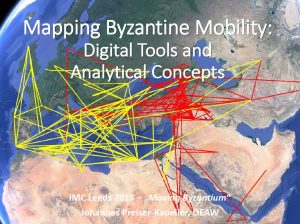CAA News Today
CAA Statement on the Removal of WPA Murals by Victor Arnautoff
posted by CAA — July 09, 2019
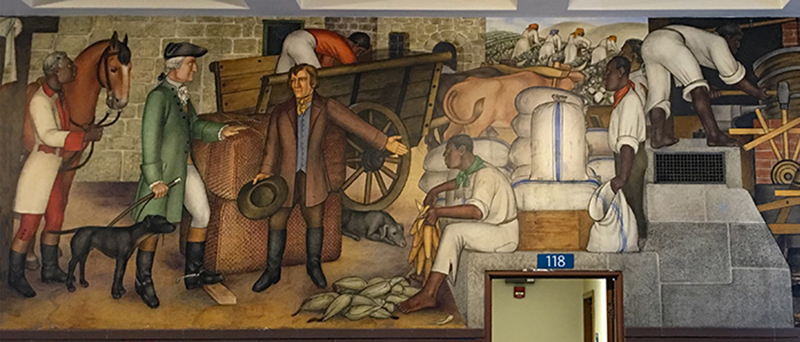
One of thirteen The Life of Washington murals by Victor Arnautoff, George Washington High School, San Francisco. Image courtesy George Washington High School Alumni Association.
On June 25th, the San Francisco Unified School District’s Board of Education voted to destroy an important series of murals by artist Victor Arnautoff, which he painted as part of the Works Progress Administration (WPA) program inside George Washington High School in 1936. The series of 13 murals, entitled The Life of Washington, includes imagery of dead Native Americans and imagery of slaves working at Washington’s Mount Vernon estate in Virginia, which the school board determined was offensive.
CAA opposes the recent ruling by the San Francisco Unified School District and its Board of Education. By voting to destroy the murals, the Board is advancing an agenda of erasing history in order to appease contemporary critics. CAA firmly believes in the preservation of art historical records and works that serve to educate and inform the public. The murals should be viewed as an opportunity to examine history, to ask questions, and to create discussion around ideas, events, and facts that are woven indisputably into American history.

David Raizman
Interim Executive Director
Editor’s note (8/21/19): The views expressed above do not necessarily represent the views of CAA’s membership.
Further reading: San Francisco School Will Cover Controversial George Washington Murals (New York Times)
A Controversial WPA Mural Is a Litmus Test for the Longevity of Public Art (Hyperallergic)
Art Professor Dewey Crumpler Defends Victor Arnautoff’s WPA Murals (National Coalition Against Censorship)
CAA Announces Inaugural Recipients of the Art History Fund for Travel to Special Exhibitions
posted by CAA — June 19, 2019
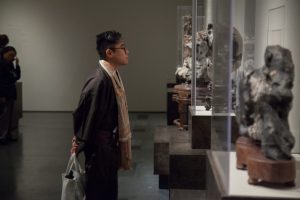
2018 CAA Annual Conference. Photo: Rafael Cardenas
In fall 2018, we announced CAA had received an anonymous gift of $1 million to fund travel for art history faculty and their students to special exhibitions related to their classwork. The generous gift established the Art History Fund for Travel to Special Exhibitions.
The jury for the Art History Fund for Travel to Special Exhibitions met in May 2019 to select the first group of recipients as part of the gift.
The awardees are:
Catherine Girard, Eastern Washington University
Class: Topics in Art History: Manet Inside Out
Exhibition: Manet and Modern Beauty at The J. Paul Getty Museum, Los Angeles
Luis Gordo Peláez, California State University Fresno
Class: Arts of the Colonial Andes
Exhibition: Art & Empire: The Golden Age of Spain at The San Diego Museum of Art
Alison Miller, University of the South
Class: Japanese Print Culture
Exhibition: Yoshitoshi: Spirit and Spectacle at the Minneapolis Institute of Art
Rachel Stephens, University of Alabama
Class: American Portraiture
Exhibition: Black Out: Silhouettes Then and Now at the Birmingham Museum of Art
“We’re delighted to announce the inaugural recipients of the Art History Fund for Travel to Special Exhibitions, a groundbreaking CAA program designed specifically to enhance students’ first-hand knowledge of works of art,” said Hunter O’Hanian, CAA’s executive director. “The new Fund places a spotlight on the critical work art history scholars are doing to grow the field, with CAA as the go-to organization supporting and advancing their work.”
The Art History Fund for Travel to Special Exhibitions supports travel, lodging, and research efforts by art history students and faculty in conjunction with special museum exhibitions in the United States and throughout the world. Awards are made exclusively to support travel to exhibitions that directly correspond to the class content, and exhibitions on all artists, periods, and areas of art history are eligible.
Applications for the second round of grants will be accepted by CAA beginning in fall 2019. Deadlines and details can be found on the Travel Grants page.
Serve on Professional Development Fellowship Juries
posted by CAA — April 22, 2019
CAA invites nominations and self-nominations for individuals to serve on our Professional Development Fellowship juries for three years (2019–22). Terms begin July 2019.
JURY VACANCIES FOR SPRING 2019
- Professional Development Fellowship in Visual Art: two members
- Professional Development Fellowship in Art History: one member
Duties and Qualifications
The fellowship juries award $10,000 each to one visual artist completing an MFA and one art historian completing a PhD in the coming year. Candidates for the art history jury must be actively publishing scholars with demonstrated seniority and achievement; candidates for the visual arts jury must be actively producing artists with a track record of exhibitions. Institutional affiliation is not required. Jury members review applications once per year and confer by conference call.
Candidates must possess expertise appropriate to the jury’s work and be current CAA members. They should not hold a position on a CAA committee or editorial board beyond May 31, 2019. CAA’s president and vice president for committees appoint jury members for service.
HOW TO APPLY
Nominations and self-nominations should include a brief statement (no more than 150 words) outlining the individual’s qualifications and experience and a CV (an abbreviated CV no more than two pages may be submitted). Please send all materials by email to Cali Buckley, CAA grants and special programs manager; submissions must be sent as Microsoft Word or Adobe PDF attachments.
For questions about jury service and responsibilities, contact Tiffany Dugan, CAA director of programs and publications.
Deadline: May 13, 2019
Member Spotlight: Nazar Kozak
posted by CAA — April 04, 2019
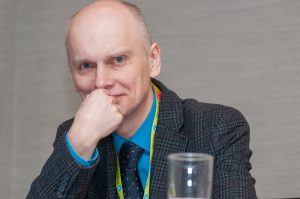
Nazar Kozak at the 2019 CAA Annual Conference. Photo: Ben Fractenberg
Up next in our Member Spotlight series, we are highlighting the work of Nazar Kozak, senior research scholar in the Department of Art History in the Ethnology Institute at the National Academy of Sciences of Ukraine, and an alumnus of the CAA-Getty International Program. Joelle Te Paske, CAA’s media and content manager, corresponded recently with Professor Kozak to learn more about his experiences at the Annual Conference, his current research, and his tips for scholars looking to extend their work internationally.
Joelle Te Paske: Hi Professor. Thanks for taking the time for our interview. So to begin, where are you from originally? What is the focus of your research?
Nazar Kozak: I am from Lviv, Ukraine, and I work in two fields simultaneously: medieval and contemporary art. The first one emerged from my interest in the cultural heritage of the region in which I live. My ongoing research in this field is focused on the sixteenth-century iconographic migrations of the Akathistos cycle across the post-Byzantine world from Venetian Cyprus in the South to the Tsardom of Muscovy in the North. Through this, I aim to discover artistic connections within this politically segmented realm that are not readily visible through archival data and thus to problematize nationalist narratives that have dominated Eastern European scholarship in the past. My second specialization emerged in recent years when issues of social justice and war came into the forefront in my country. I was driven to document and re-think artistic responses to the turmoil of events and through this to make my art history relevant to the times I am living through socially and politically. Currently, I am working on an article that explores how border art resists a global biopolitical divide.
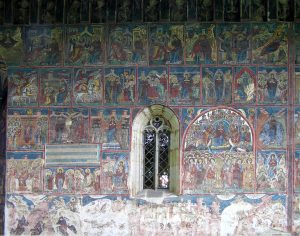
Akathistos cycle on the south facade of the Dormition Church in Humor, 1535. Photo: Nazar Kozak
JTP: What is your favorite thing about being a CAA member? Do you have a favorite memory?
NK: My favorite part of being a member is attending the Annual Conference. I remember the reaction of the audience to my talk at the Global Conversation session in 2017 when I shared my personal crisis in finding a motivation to continue writing art historical research when war broke out in my country and how I eventually found that motivation. The room was crowded and I remember the anxiety that I had before the session and the confidence I felt when I spoke and also during several moving conversations I had with attendees afterwards. That talk was published on the CAA website.
JTP: What is the most exciting part of your work currently?
NK: Currently and always the most exciting moment is when I realize that my work on a scholarly project is done; that is, when I can confirm my intellectual hypothesis and substantiate it with evidence that I genuinely believe to be true for now. This feeling, of course, does not last forever.
JTP: What would you say are some of the challenges?
NK: The major challenge is to find a sustainable answer for the Why question: Why am I writing a particular paper or monograph? And not just a random answer to tell others, but an answer I can tell myself and stick with, at least until I finish writing. The access to material and writing itself is a challenge, of course, but I think when you know your stake in it you can handle all the rest.
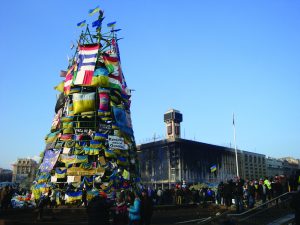
A view of Independence Square in Kyiv after violent clashes with the police during the Maidan Revolution, January 21, 2014. Photo: Borys Harasymiv
JTP: What is a favorite study you’ve worked on over the years? Any recommendations for our readers?
NK: Right now it is my article on art interventions during the Ukrainian Maidan revolution published in Art Journal in 2017.
I would recommend Decolonizing Nature: Contemporary Art and the Politics of Ecology by T.J. Demos, because it is a great piece of engaging scholarship and because art and ecology is a crucial issue that is relevant to us all.
For those who are interested in online resources on Byzantine art I would recommend The Digital Research Archive for Byzantium (DIFAB) and North of Byzantium.
JTP: What is your experience with Humanities Commons and the CAA-Getty program?
NK: I have used Humanities Commons several times as a platform for online discussions which have worked well as a supplement for in-person exchanges. Among other online platforms that I use is Academia.edu though I see its commercialization as controversial. The CAA-Getty International Program is the major vehicle that facilitates scholars from countries where art history has fewer resources than in West Europe or North America to bring their voice and to build their professional networks on the global scale. I participated in that program three times: first as a scholar and twice as an alumnus. This year I was selected to collaborate with the program’s director Janet Landay and the current CAA International Committee chair Pearlie Rose Baluyut to design and moderate the preconference colloquium on international topics in art history and I was honored to have that opportunity not only for my benefit but to contribute to the program as well. I might add that because of my work with the CAA-Getty program I have recently joined CAA’s International Committee, where I look forward to continuing to work on recruiting and interacting with international scholars.
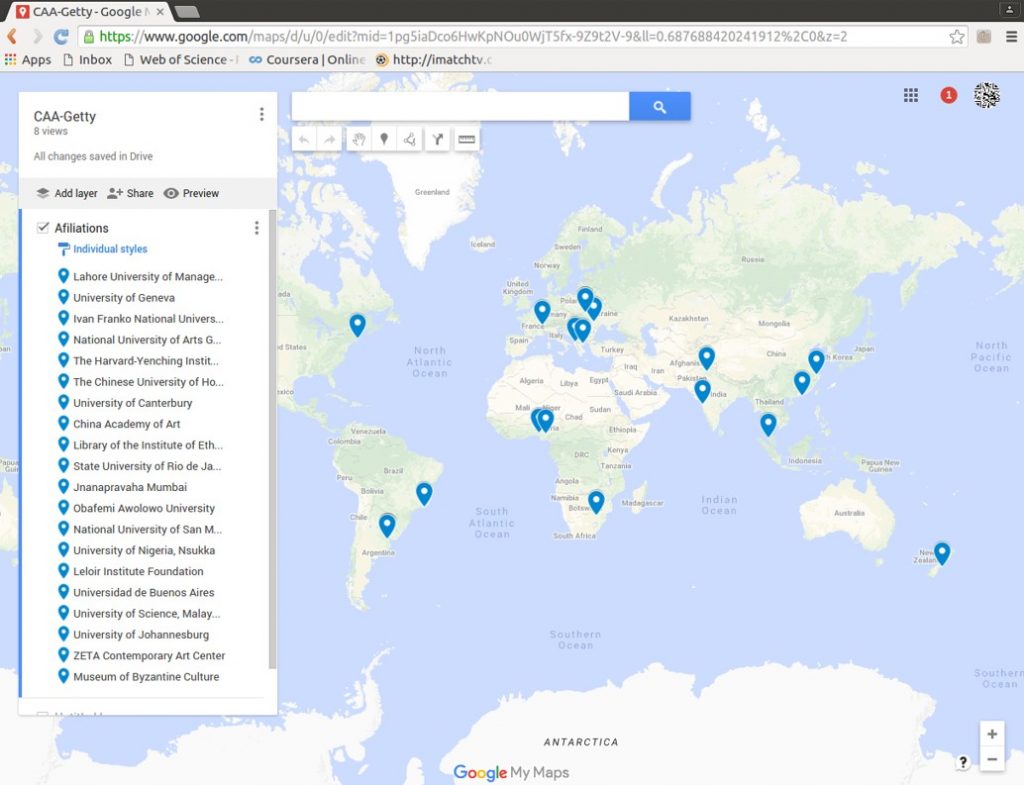
Map of home institutions of 2019 CAA-Getty International Program participants. Learn more.
Nazar Kozak is a senior research scholar in the Department of Art History in the Ethnology Institute at the National Academy of Sciences of Ukraine. Previously he also taught at the Medieval and Byzantine Studies Department at the Ivan Franko National University of Lviv. After receiving his PhD from the Lviv Academy of Arts in 2000, he spent a year in Greece under the auspices of the State Scholarships Foundation (IKY). Kozak is a recipient of research and publication grants from the American Council of Learned Societies (ACLS) and an alumnus of the CAA-Getty International Program. In 2016-2017, he was a visiting Fulbright Scholar in The Ukrainian Museum in New York. Kozak is the author of a monograph on image and authority in Kyivan Rus’ and articles dealing with Byzantine and post-Byzantine wall-paintings preserved in Ukraine. His ongoing research is focused on the sixteenth-century iconographic migrations of the Akathistos cycle across the post-Byzantine world. More recently, Kozak has also begun to work on topics in contemporary art. His article on the art interventions during the Ukrainian Maidan published in the Spring 2017 issue of the Art Journal received an honorable mention as a finalist for that year’s Art Journal Award.
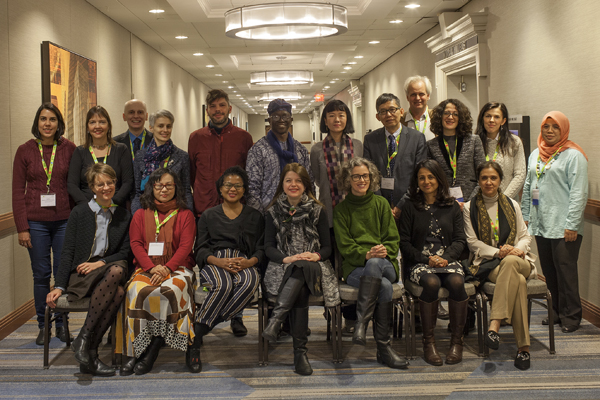
Nazar Kozak (third from top left) and fellow 2019 CAA-Getty International Program participants.
Join the Jury for the Art History Special Exhibition Travel Fund
posted by CAA — January 17, 2019
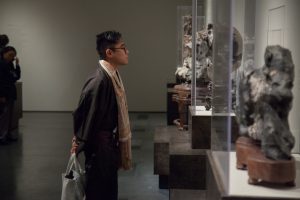
Attendee at 2018 CAA Annual Conference in Los Angeles. Photo: Rafael Cardenas
The Art History Special Exhibition Travel Fund jury is looking for members.
The deadline is January 31, 2019.
In August, we announced that CAA received a major anonymous gift of $1 million to fund travel for art history faculty and their students to special exhibitions related to their classwork. The fund is designed to award up to $10,000 to qualifying undergraduate and graduate art history classes to cover students’ and instructors’ costs (travel, accommodations, and admissions fees) associated with attending museum special exhibitions throughout the United States and worldwide. The purpose of the grants is to enhance students’ first-hand knowledge of original works of art.
Jury members will review applications in February 2019 and confer by conference call or in person if necessary. After staggering jury cycles are established, jurors serve for a three-year term.
Jury members are comprised of art historians and a museum curator. Candidates must be CAA members and should not currently serve on another CAA editorial board or committee. CAA’s president appoints jury members for service. Jury members may not themselves apply for a grant in this program during their term of service. Members shall be entitled to a nominal honorarium in recognition of their service.
Nominators should ascertain their nominee’s willingness to serve before submitting a name; self-nominations are also welcome.
Please send a letter describing your interest in and qualifications for appointment, along with a CV (two pages maximum) to Cali Buckley, Grants and Special Programs Manager, at cbuckley@collegeart.org.
Member Spotlight: Renata Holod
posted by CAA — December 18, 2018
Renata Holod is College of Women Class of 1963 Term Professor in the Humanities, at the History of Art Department, and Curator, Near East Section, Museum of Archaeology and Anthropology, at the University of Pennsylvania. She has carried out archaeological and architectural fieldwork in Syria, Iran, Morocco, Turkey, Central Asia, Tunisia, and Ukraine, and is the author of numerous books and essays.
CAA media and content manager Joelle Te Paske corresponded recently with Professor Holod to learn more about what she’s working on.

Joelle Te Paske: Thank you for taking the time, Professor. So to begin, where are you from originally?
Renata Holod: I was born in Ukraine, and grew up in Edmonton, Alberta and then Toronto, Ontario, Canada.
I have a BA in Islamic Studies from the University of Toronto; a MA from University of Michigan in the History of Art, and my PhD from Harvard in Fine Arts.
JTP: What led you to the work you do now?
RH: My work on projects varies in date and methodology, from archaeology (I worked in Syria, and Tunisia), to architectural and regional history of different periods and locations (including fourteenth- to fifteenth-century architecture, settings and cities in greater Iran, and contemporary architecture from Morocco to Indonesia), to work on objects and collections (ceramics, the late Ottoman painter Osman Hamdi Bey). I get bored quickly.
JTP: You’ve been a CAA member for over 40 years. How has the field changed?
RH: There are many more practitioners in my particular field. In fact, it is no longer one field, but could be divided into regional and temporal sub-fields. There is much more theorization, and also expanded archival work (e.g. Ottoman archives), and now digital humanities, etc.
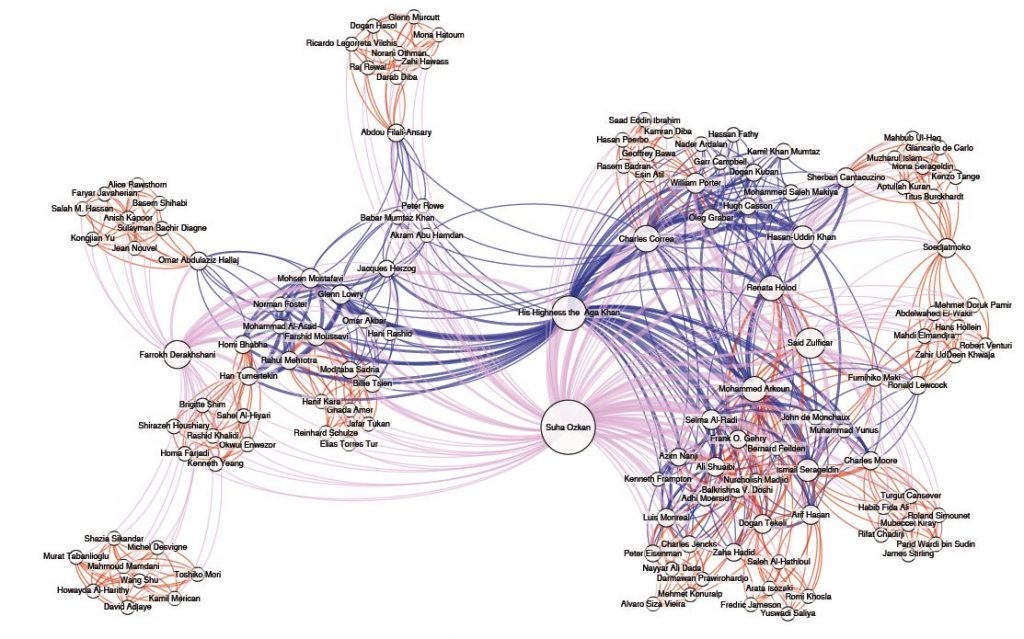
JTP: What is the most exciting part of your work currently?
RH: Studying unpublished objects, and redoing the galleries and publishing the Middle East collection for the later periods (Parthian through the nineteenth century) at the Penn Museum.
JTP: A favorite exhibition or study you’ve worked on over the years?
RH: Whichever one is currently being submitted.
JTP: What is your top recommendation for our readers?
RH: Network Theory and its application; see the work of my former student, Yael Rice on Mughal workshops, as well as the work of Johannes Preiser-Kappeler (Vienna).
JTP: What is a favorite memory from a CAA conference?
RH: Seeing my former students give papers; and meeting my former classmates.
JTP: Thank you, Professor Holod.
Renata Holod is College of Women Class of 1963 Term Professor in the Humanities, at the History of Art Department, and Curator, Near East Section, Museum of Archaeology and Anthropology, at the University of Pennsylvania. She has carried out archaeological and architectural fieldwork in Syria, Iran, Morocco, Turkey, Central Asia, Tunisia, and Ukraine. She is co-author of City in the Desert: Qasr al- Hayr East (1978); Architecture and Community: Building in the Islamic World Today (1983); The Mosque and the Modern World (1997); The City in the Islamic World (2008) and An Island Through Time: Jerba Studies (2009). She was recently part of the team redoing the Middle East galleries at the Penn Museum, with a special issue of Expedition magazine and a new handbook as well. Her most recent articles are: “Approaching the Mosque: Birth and Evolution” in The World of the Mosque: Magnificent Designs (New York: Rizzoli, 2017) 14-21, and “Jerba in the 3rd/9th century CE: Under Aghlabi Control?” in The Aghlabids & their Neighbors: Art & Material Culture in Ninth-Century North Africa, Glaire D. Anderson, Corisande Fenwick, and Mariam Rosser-Owen, eds. (Leiden: Brill, HdO series, 2017), 451- 469. On several international advisory and editorial boards, she has also served as President, Board of Trustees at The Ukrainian Museum in NYC, 2013-2017.
Editor-in-Chief Sought for Art Journal Open
posted by CAA — December 17, 2018
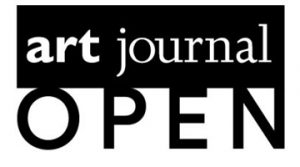
The Art Journal Editorial Board invites nominations and self-nominations for the position of editor-in-chief of Art Journal Open for the term of July 1, 2020–June 30, 2023 (with service as incoming editor designate, July 1, 2019–June 30, 2020). A candidate may be an artist, art historian, critic, educator, curator, or other professional within the membership served by CAA; institutional affiliation is not required. Art Journal Open is an online forum for the visual arts that presents artists’ projects, conversations and interviews, scholarly essays, and other content from across the cultural field. The independently edited journal publishes original material by artists, scholars, teachers, archivists, curators, critics, and other cultural producers and commentators, with a commitment to foster new intellectual exchanges about contemporary art and culture. Art Journal Open prioritizes material that makes meaningful use of the web, such as multimedia formats and techniques, and is published on a continual, rolling basis.
The editor is responsible for commissioning all content for Art Journal Open. He or she solicits or commissions projects, texts, and time-based content by artists and other authors, and determines the appropriate scope and format of each project. Working in consultation with the Art Journal editor-in-chief, reviews editor, and editorial board, the editor determines which pieces should undergo peer review and subsequent revision before acceptance. The editor also works with authors and a CAA staff editor on the development and preparation of materials for publication. The editorial board expects that a significant portion of the journal will be geared to work or concerns of artists, and that the editor will endeavor to give voice to underrepresented perspectives. Qualifications for the position include a broad knowledge of current art, the ability to work closely with artists in a wide variety of practices, and experience in developing written and other content for arts platforms. The position includes membership on the editorial board and, after the orientation period, an annual honorarium, paid quarterly for the three years the of the editorship. The editor attends the three meetings each year of the Art Journal Editorial Board and, as an ex-officio member, of the Publications Committee—held in New York or by teleconference in the spring and fall, and at the CAA Annual Conference in February—and submits an annual report to CAA’s Board of Directors.
Candidates must be current CAA members and should not serve concurrently on the editorial board of a competitive journal or on another CAA editorial board or committee. The editor-in-chief may not publish her or his own work on Art Journal Open or in Art Journal during the term of service. Nominators should ascertain a nominee’s willingness to serve before submitting a name; self-nominations are also welcome. Please send a letter describing your interest in and qualifications for the position, a CV, and at least one letter of recommendation to: Art Journal Open Editor Search, CAA, 50 Broadway, 21st floor, New York, NY 10004; or email the documents to Heather Holmes (hholmes@collegeart.org), CAA Associate Editor for Digital Publications.
Deadline: April 1, 2019; finalists will be interviewed on May 2 in New York.
Announcing Milette Gaifman and Lillian Lan-ying Tseng as Coeditors of The Art Bulletin
posted by CAA — December 06, 2018
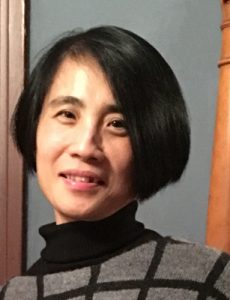
Lillian Lan-ying Tseng
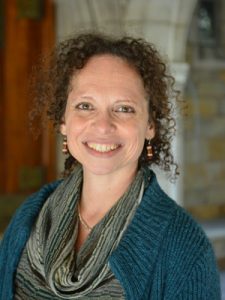
Milette Gaifman
We’re pleased to announce the appointment of Lillian Lan-ying Tseng and Milette Gaifman as the new coeditors of The Art Bulletin. The appointment marks the first joint editorship in the 105-year history of the journal. The Art Bulletin is the flagship journal of art history, covering prehistoric to 21st-century art. Previous editors of The Art Bulletin have included H. W. Janson, George Kubler, Millard Meiss, and John Shapley, among many others. The Art Bulletin editorship rotates every three years.
“CAA believes in interdisciplinary practice and collaboration in all programs and publications. The Art Bulletin’s rich and long history as the journal of record for the art history field will only benefit from this new coeditor approach,” said Hunter O’Hanian, executive director of CAA. “Professors Tseng and Gaifman are highly respected in the field and will bring to the journal diverse experiences and expertise that will be reflected in The Art Bulletin over the years of their editorship.”
Lillian Lan-ying Tseng is associate professor of East Asian art and archaeology at the Institute for the Study of the Ancient World at New York University and specializes in Chinese art and archaeology. The mediums she investigates are diverse, including city planning, architecture, sculpture, painting, calligraphy, textile, and bronze objects. The timeframes of her publications cluster in early imperial China, later imperial China, and the twentieth century. The issues she explores concern not only art objects but also broader contexts in which they are situated, such as how artisans appropriated scientific knowledge for religious purposes, how memory facilitated the creation, circulation, and reception of artifacts, and how political intentions or situations stimulated the development of visual and material cultures. She is the author of Picturing Heaven in Early China (Harvard University Press, 2011). She is currently at work on two book projects: one looks into the reception of antiquity and its impact on visual production in 18th-century China, while the other examines frontiers and visual imaginations in Han China.
“Art and visual culture are central elements in the study of ancient civilizations, as they are of all periods of history,” said Alexander Jones, Leon Levy Director and Professor of the Exact Sciences in Antiquity, Institute for the Study of the Ancient World, NYU. “The Institute for the Study of the Ancient World is proud and delighted on the occasion of Lillian Tseng’s appointment as coeditor of The Art Bulletin.”
Milette Gaifman is associate professor of classics and history of art at Yale University. She is a scholar of ancient art and archaeology, focusing primarily on Greek art of the Archaic and Classical periods. At Yale, she is jointly appointed in the departments of Classics and History of Art. Her research interests include the interaction between visual culture and religion, the variety of forms in the arts of antiquity, the interactive traits of various artistic media, and the reception of Greek art in later periods. In addition, her scholarship explores the historiography of the academic disciplines of art history and archaeology. She is the author of Aniconism in Greek Antiquity (Oxford University Press, 2012), and The Art of Libation in Classical Athens (Yale University Press, 2018); and coeditor of “Exploring Aniconism,” a thematic issue of Religion (2017), and “The Embodied Object in Classical Art,” a special issue of Art History (June 2018).
“It is a significant honor for Yale and for the field of Classical Greek Art that Milette Gaifman has been appointed co-editor of The Art Bulletin. Successor in this role to such hallowed Yale luminaries as Creighton Gilbert and Walter Cahn, Milette will bring the same dynamism and intellectual energy to the position that can be seen in her publications and her hugely successful teaching in our Department,” said Timothy Barringer, Chair and Paul Mellon Professor in the Department of the History of Art at Yale University. “Author of two path-breaking books, Milette is a scholar of wide-ranging tastes and interests, who insists on methodological rigor but also enjoys crossing scholarly borders and dismantling the shibboleths of orthodox thinking. Working with our respected former colleague, Lillian Tseng, she will doubtless bring a new, iconoclastic and perhaps occasionally irreverent spirit to an august journal.”
CAA Announces Notable Speakers for 2019 Annual Conference in New York
posted by CAA — December 03, 2018
Artist Joyce J. Scott leads as Keynote; Distinguished Scholar Elizabeth Hill Boone; Artist Interviews with Julie Mehretu and Julia Bryan-Wilson and Guadalupe Maravilla and Sheila Maldonado; Designer Stephen Burks, and Douglas Dreishpoon and Randy Kennedy with Mary Helimann, Bob Stewart, and John Giorno, among many other notable speakers and presenters
The Getty Foundation to receive the Outstanding Leadership in Philanthropy Award
We’re delighted to announce the following special guests will be presenting at the 107th CAA Annual Conference, taking place February 13-16, 2019, at the New York Hilton Midtown.
Keynote Speaker
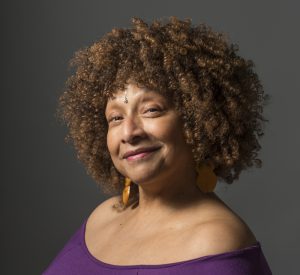
Joyce J. Scott. Photo: John Dean
The Keynote Speaker for the 107th CAA Annual Conference will be Joyce J. Scott, sculptor and craftsperson and 2016 MacArthur Fellow. Scott is best known for her figurative sculpture and jewelry using free-form off-loom bead weaving techniques similar to a peyote stitch, as well as blown glass, and found objects. Over the past 50 years, Scott has established herself as an innovative fiber artist, print maker, installation, and performing artist. She explores challenging subjects, powerfully revealing the equality between materials and practices often associated with “craft” and “fine art.”
Scott is the recipient of myriad commissions, grants, awards, residencies, and prestigious honors from the National Endowment for the Arts, the Louis Comfort Tiffany Foundation, Anonymous Was a Woman, American Craft Council, National Living Treasure Award, and has received a Lifetime Achievement Award from the Women’s Caucus for the Arts, a Mary Sawyers Imboden Baker Award, among others.
CAA Convocation featuring Joyce J. Scott’s Keynote will take place Wednesday, February 13, 2019, from 6-7:30 PM. Free and open to the public.
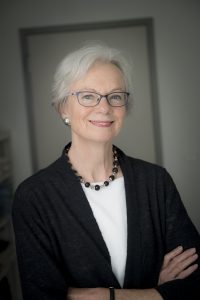
Elizabeth Hill Boone. Photo: Paula Burch
Distinguished Scholar
The Distinguished Scholar for the 107th CAA Annual Conference will be Elizabeth Hill Boone, Professor of History of Art and Martha and Donald Robertson Chair in Latin American Art at Tulane University. An expert in the Pre-Columbian and early colonial art of Latin America with an emphasis on Mexico, Professor Boone is the former Director of Pre-Columbian Studies at Dumbarton Oaks and recipient of numerous honors and fellowships, including the Order of the Aztec Eagle, awarded by the Mexican government in 1990. Read our interview with Elizabeth Hill Boone.
The Distinguished Scholar Session will take place Thursday, February 14, 2019, from 4-5:30 PM.
Distinguished Artist Interviews
The Annual Artist Interviews will feature two artist interviews: Julie Mehretu interviewed by Julia Bryan-Wilson and Guadalupe Maravilla interviewed by Sheila Maldonado.
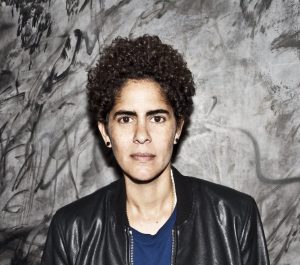
Julie Mehretu. Photo: Anastasia Muna
Julie Mehretu is a world-renowned painter, born in Addis Ababa, Ethiopia in 1970, who lives and works in New York City and Berlin. She received a Master’s of Fine Art with honors from The Rhode Island School of Design in 1997. Mehretu is a recipient of many awards, including the The MacArthur Fellowship (2005) and the US Department of State Medal of Arts Award (2015). She is best known for her large-scale paintings that take the abstract energy, topography, and sensibility of global urban landscapes and political unrest as a source of inspiration. She has shown her work extensively in international and national solo and group exhibitions and is represented in public and private collections around the world. Julia Bryan-Wilson is Doris and Clarence Malo Chair and Professor of Modern and Contemporary Art at University of California, Berkeley.
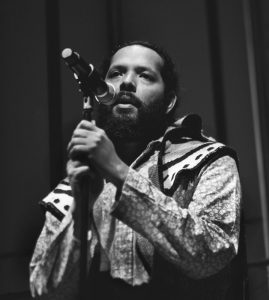
Guadalupe Maravilla. Photo: Raul Rodarte Torres
Guadalupe Maravilla (formally Irvin Morazan) was part of the first wave of undocumented children to arrive at the United States border in the 1980s from Central America. In 2016, as a gesture of solidarity with his undocumented father (who uses Maravilla as his last name in his fake identity) Irvin Morazan changed his name to Guadalupe Maravilla. Maravilla has performed and presented his work extensively in venues such as the Whitney Museum of American Art, New Museum, The Metropolitan Museum of Art, The Bronx Museum, El Museo Del Barrio, Jersey City Museum, Caribbean Museum (Colombia), and MARTE Museum (El Salvador). His work has been recognized by numerous awards and fellowships including, Franklin Furnace, Creative Capital Grant, Joan Mitchell Emerging Artist Grant, Art Matters Grant & Fellowship, Virginia Museum of Fine Arts Fellowship, Dedalus Foundation Fellowship and the Robert Mapplethorpe Foundation. Sheila Maldonado is a New York-based writer and poet, whose family hails from Honduras.
The Distinguished Artist Interviews will take place Friday, February 15, 2019, 3:30-5:30 PM. Free and open to the public.
CAA Committee on Design Featured Speaker
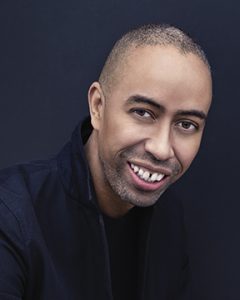
Stephen Burks. Photo: Photography Emin
CAA is also pleased to announce that designer Stephen Burks will speak at the Annual Conference in a special event of the CAA Committee on Design. Burks will lead a talk titled, “Objects of African Descent: Tracing the lineage and influence of everyday African objects and culture throughout the diaspora and beyond.” Burks believes in a pluralistic vision of design inclusive of all cultural perspectives. For his efforts with artisan groups around the world, he has been called a design activist. His ongoing Man Made project bridges the gap between authentic developing world production, industrial manufacturing, and contemporary design. Independently and through association with the nonprofits Aid To Artisans, Artesanias de Colombia, the Clinton Global Initiative, Design Network Africa, and the Nature Conservancy, Burks has consulted on product development with artisan communities throughout the world. In addition, leading, manufacturers have commissioned his studio, Stephen Burks Man Made, to develop lifestyle collections that engage hand production as a strategy for innovation. In 2015, Burks was awarded the National Design Award in product design and in 2018, the Harvard Loeb Fellowship.
UPDATE, January 28, 2019: Unfortunately due to scheduling conflicts this event is canceled. Explore other presentations on design here.
Outstanding Leadership in Philanthropy Award

For the second year, CAA will present the Outstanding Leadership in Philanthropy Award to a foundation or philanthropic organization that has established a record of exceptional generosity and civic and charitable responsibility. This year’s award will be given to the Getty Foundation.
CAA Announces Guidelines for Addressing Proposed Cuts to Arts and Humanities Programs and Departments
posted by CAA — November 12, 2018
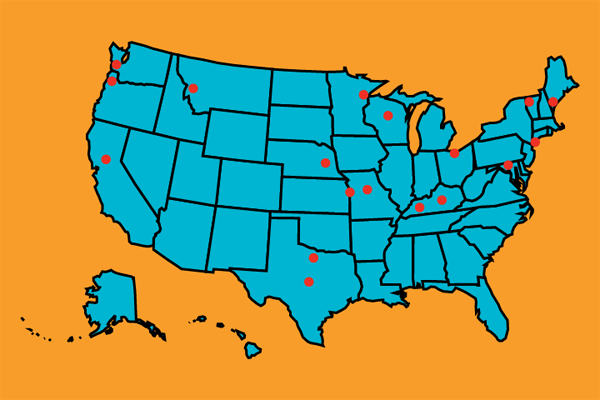
Campuses across the country have been affected by cuts to the arts and humanities. See the full list here. Graphic: Allison Walters
By any number of metrics, the arts and humanities are experiencing challenging times. Funding is under threat from the Federal government. Student enrollment is dropping in higher education classes focusing on the arts and humanities. The number of tenure-track faculty positions are diminishing in arts and humanities departments. The wide support of STEM-centered education has placed an emphasis on career paths with measurable and immediate financial outcomes. Yet, we know the importance of an arts and humanities education, not just for those looking to have careers in the arts and humanities but those across the entire professional spectrum.
In response to the challenges in the arts and humanities, some universities and colleges in the United States have cut programs, collapsed libraries, or shuttered entire departments. These steps, taken as cost-saving measures, only increase the uphill battle for the arts and humanities. Over the past years, CAA has tracked these changes in higher education through the organization’s own research efforts and through narratives relayed directly from our members. These actions taken by administrations are in no way secret. In article after article, the alarm has been sounded. We believe there is a better way to resolve these issues and protect the arts and humanities at the same time.
To bridge this divide, CAA is pleased to release “Guidelines for Addressing Proposed Substantive Changes to an Art, Art History or Design Unit, or Program at Colleges and Universities.”
“These guidelines provide a path for open communication between faculty and administration,” says Hunter O’Hanian, executive director of CAA. “With this new tool to be used by both administrations and faculty equally, CAA builds a resource that is vital to strengthening the arts and humanities on campuses. The guidelines create clearly definable steps and parameters for a process that when handled badly leads to fissures between faculty, students, and administrations.”
The “Guidelines for Addressing Proposed Substantive Changes to an Art, Art History or Design Unit or Program at Colleges and Universities” call for a deeper understanding of the factors and issues that have precipitated the action to close a department or program. The guidelines outline two clear paths: they encourage constituencies to communicate about the potential changes, and they pave the way to resolution without having to eliminate or downsize the program or department.
If those conversations fail to reach a satisfactory outcome with the educational institution, the guidelines emphasize that the institutional administration must do everything it can to see that the program continues. And, as is the case with all scholastic endeavors, the administrations must show their work—they must provide documentation that the department has been adequately resourced and funded. It must demonstrate that growth has been encouraged rather than to allowing it to lay fallow.
“CAA remains convinced that students and society derive lasting benefit when institutions offer a diverse range of academic resources to support different learning styles,” says Jim Hopfensperger, president of the CAA Board of Directors. “These new CAA guidelines outline best practices toward sustaining this essential diversity of academic programs and operational assets.”
Hopfensperger adds that “CAA believes that students, staff, faculty, and institutional leadership teams are all well served by inclusive processes, open lines of communication, engagement across constituencies, and empathetic deliberations.”
IMPACT OF ARTS AND HUMANITIES TOOLKIT
COLLEGES FACING CUTS TO ARTS AND HUMANITIES PROGRAMS
Authors and Contributors for the “Guidelines for Addressing Proposed Substantive Changes to an Art, Art History or Design Unit or Program at Colleges and Universities”:
CAA Working Group for Guidelines for Addressing Proposed Substantive Changes to an Art, Art History or Design Unit or Program at Colleges and Universities: Tom Berding, Michigan State University; Brian Bishop, Framingham State University (Chair, CAA Professional Practices Committee); James Hopfensperger, Western Michigan University (CAA Board President); Charles Kanwischer, Bowling Green State University; Karen Leader, Florida Atlantic University; Richard Lubben, College of the Sequoias; Paul Jaskot, Duke University; Hunter O’Hanian, CAA Executive Director.



